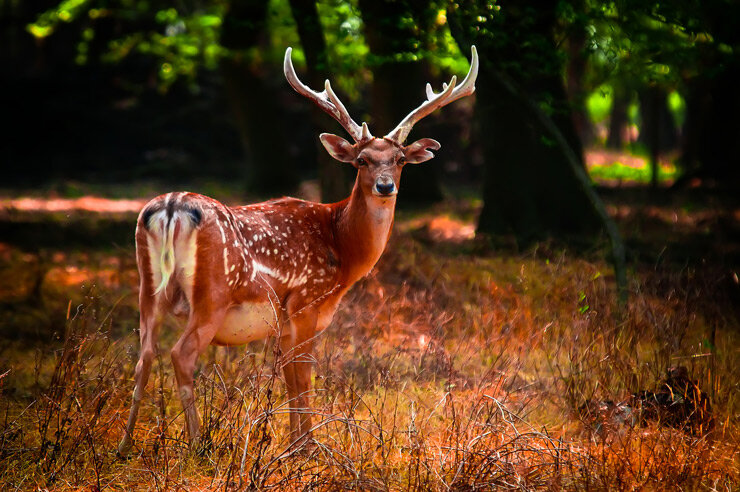Ashk Island, a haven for Persian fallow deer

TEHRAN – The Ashk Island of Lake Urmia, which is considered one of the most important habitats of rare Persian fallow deer, has become a safe place to protect the species from extinction due to the difficult access of illegal poachers.
Shared between West Azarbaijan and East Azarbaijan provinces in northwestern Iran, Lake Urmia, was once the largest salt-water lake in West Asia.
However, decades of long-standing drought spells and elevated hot summer temperatures that speed up evaporation as well as increased water demands in the agriculture sector shrank the lake drastically. In 1999 the volume of water which was at 30 billion cubic meters drastically decreased to half a billion cubic meters in 2013. Moreover, the lake surface area of 5,000 square kilometers in 1997 shrunk to one-tenth of that to 500 square kilometers in 2013.
Lake Urmia had approximately 102 islands; Shahi island was historically the lake's largest. Some of the islands have a rich ecosystem due to being out of reach, including Kaboudan, Arezoo, Spir, and Ashk islands.
Moving on the southern route, you can reach the shores of Ashk Island, a special habitat of Persian fallow deer, in the middle of 5,700 km of Lake Urmia within 2 hours.
Being encircled by salt rocks has made it inaccessible to reach except for the few rangers who travel to the island every day to monitor.
The vegetation of Ashk Island is similar to those of Zagros forests, as wild almond and pistachio can be seen everywhere in this calm and beautiful place.
Ashk and Kaboodan islands were the main habitats for two herbivorous species of Persian fallow deer and Armenian mouflon, which have been endangered due to the lake's improper conditions in recent years.
The Persian fallow deer is a rare deer native to West Asia, today occurring only in Iran and Israel. It has been listed as endangered on the IUCN Red List since 2008. After a captive breeding program, the population has rebounded from only a handful of deer in the 1960s to over a thousand individuals today. It has also successfully been reintroduced into the wild.
Persian fallow deer after four or five years of severe water shortage is now benefiting from water and food availability and is feeding on tree branches and grassy vegetation that grow everywhere thanks to heavy rainfall and paved the way for life for this unique mammal.
The population of the valuable species in Lake Urmia National Park started shrinking year by year, from 255 in 2012 to 166 in 2014 and 55 in 2019, so the need to revitalize the lake and the Island of Ashk multiplied.
The arrival of Armenian mouflon and wild goats to the Island due to water shortage and the connection of the islands to each other caused a decrease in food for the deer; also carnivores such as leopards, wolves, and foxes also entered the ecosystem, and the life of this creature became endangered.
Therefore, the Department of Environment decided to prepare and implement plans on reviving the endangered ecosystem and wildlife of the Lake Urmia islands.
The most important member of Lake Urmia wildlife
Damage to the environmental infrastructure of the province, especially the natural environment and wildlife of the lake national park and the surrounding islands are among the most important damages, Mehran Nazari, head of the provincial DOE stated.
Referring to the damages over the last two decades, he said that Persian fallow deer, as a unique species that lived in these islands, left with decreasing water level and vegetation.
Some of these deer were preyed upon by invasive species such as foxes, leopards, and jackals that had made their way to the islands from other areas, some also fell prey to the illegal hunters, he lamented.
Expressing that increasing the water level of Lake Urmia was a solution to these problems, he noted that “in recent years, due to the rising water level of the lake, the movement of boats has become possible and monitoring wildlife has resumed.”
The revitalization of Lake Urmia has made a significant contribution to wildlife and vegetation, and we can soon see a resurgence in this ecosystem and the reproduction of species on the islands, he highlighted.
A conservation program for deer is being implemented to protect the animal, he further emphasized.
“The live capture of leopards and carnivores that enter the island from other areas are part of environmental programs,” he added.
Currently, five species of mammals live in Lake Urmia National Park, including 1,400 wild goats, 55 Persian fallow deer, foxes, jackals, and leopards, which are mostly on Kaboodan Island, he concluded.
FB/MG
Leave a Comment